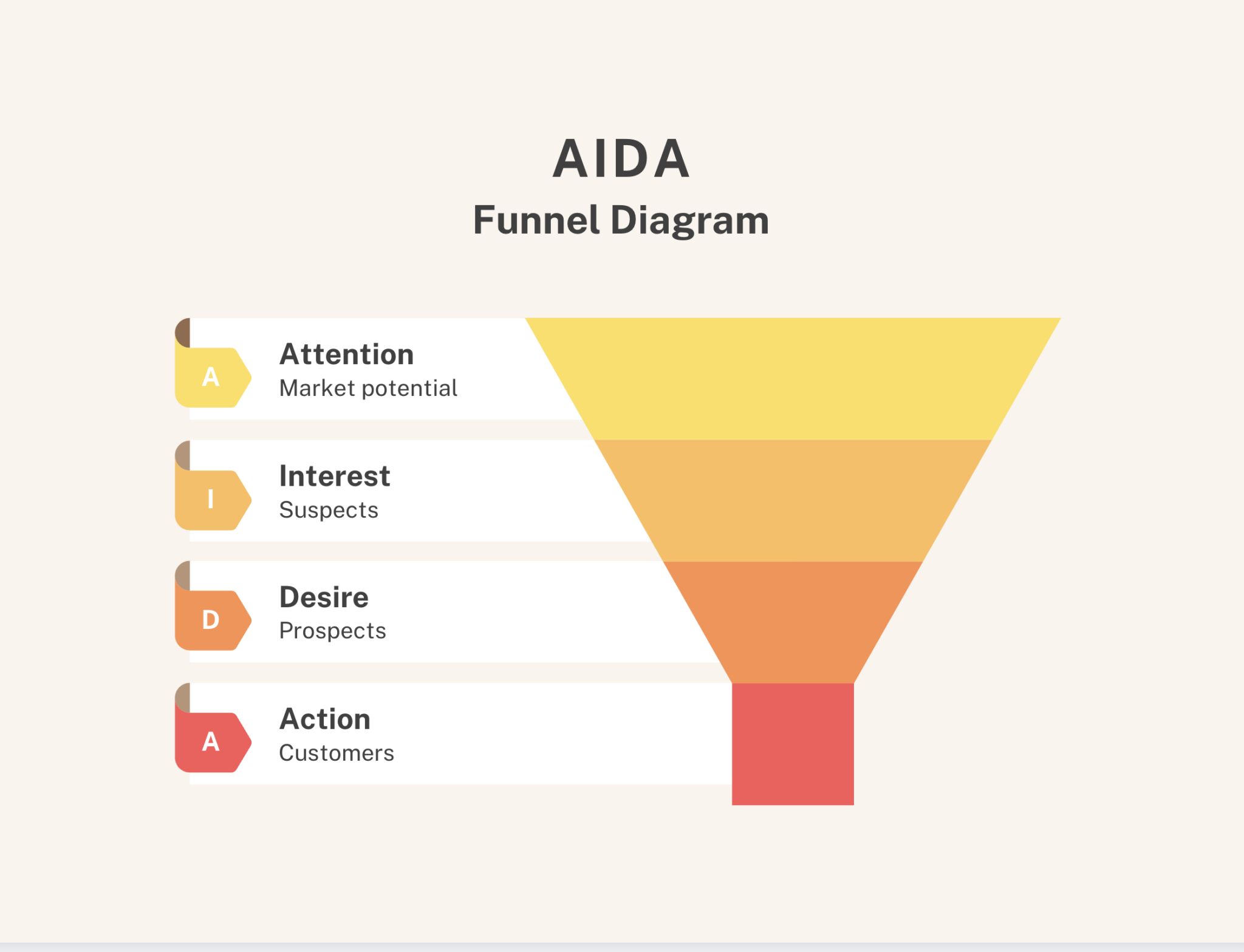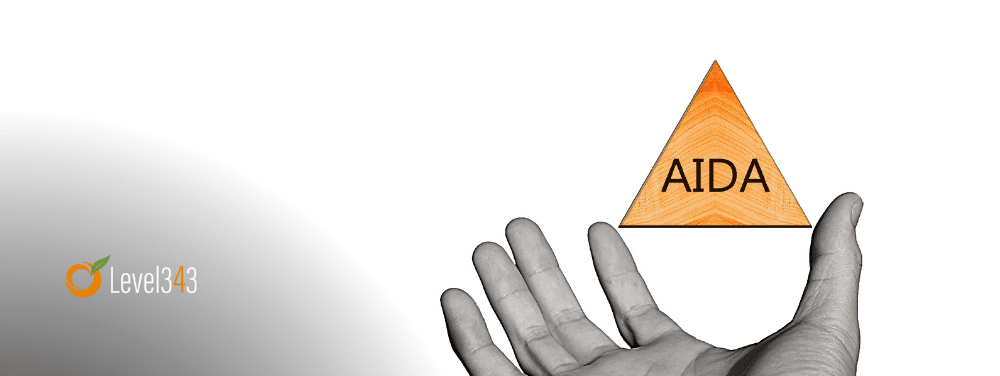Table of contents
- What Is The AIDA Model?
- Awareness (Attention)
- Putting It Into Practice
- Interest
- Desire
- Action
- Relating The AIDA Model To Your Online Marketing Activities
- A.I.D.A. Awareness, Interest, Desire and Action
- Building Brand Awareness
- Building Brand Interest
- Creating Product Desire
- Inspiring Action
- Lead Conversion
- Conclusion
When I wrote my first AIDA model article back in 2012 I wanted to explain how it can help with your online presence, what I didn’t expect is how this would progress into being a cornerstone of everything that has to do with branding, authority, psychology and interest rolled into one.
The AIDA model is a powerful tool for B2C and B2B sales teams because it provides a clear roadmap for converting leads into customers. By following the AIDA model, sales teams can focus their efforts on each stage of the funnel and know exactly what needs to be done in order to move prospects through the funnel successfully. Additionally, the AIDA model is flexible enough to be adapted to different business models and industries, making it a versatile tool for any B2B sales team or B2C marketing campaign.
What Is The AIDA Model?
AIDA is an age-old marketing concept. The acronym stands for: Awareness (or Attention), Interest, Desire, and Action.
The purpose of this method is to allow you to target your niche or demographic with systematic diligence, so you can create a sales funnel that truly works. Below is a breakdown of each individual part of this classic acronym and what it means. Let’s discover how each can be used effectively as part of your SEO and Internet marketing techniques.
Awareness (Attention)
Awareness has two tiers to it: branding (image) and attraction. Generally, the AIDA method refers to the ability for your advertisements, website, and landing page to attract that initial attention or awareness to begin with. How is this accomplished?
A/B Testing can quickly reveal which attention grabbers are working, versus those that immediately bounce (Teflon, anyone?). It isolates two versions of an element (ad copy/headlines, pictures, graphics, layout, navigation, search results links and website content), and allows you to compare minute or major changes in the element.
For example, a small A/B test can be changing the color and sizes of your headlines to see if one would perform better than another.

One way to measure this specifically is by cross comparing the actual Clicks Per Impression (CPI) rate of your ads or other content. If, for instance, you’re generating hundreds of thousands of impressions only to get a few dozen clicks connected to those impressions, your initial responses are lacking.
This is an indication that your first impression is ineffective at garnering the Attention or Awareness of your target audience.
Again, this isn’t just about your headlines or ads; it can apply to each page of your website. If a certain page is resulting in a high Bounce Rate (BR) and has become a stumbling block, that particular page is hindering Awareness or Attention at the early stages of sales conversion potential.
You don’t have to have ads to be able to measure CPI. For example, Google Search Console gives you data on how many impressions you may have gotten for a particular key term, and how many clicks you got for that impression.
The CTR (click through rate) of your search snippets can also provide an indicator of your first impression.
Putting It Into Practice
Try continuously tweaking each element, one at a time, until your Clicks Per Impression reach a minimum of 10-20%. Track how well the changes do through A/B Testing (Google Website Optimizer works well for many business types and sizes).
You can apply this to guest posts as well, especially if you have a good relationship with the site you placed the post on. If they’re willing to share their traffic numbers for that page, you can compare that to your referral numbers from the URL.
Statistically, most initial attention-based responses to a well-targeted piece of content or ad copy should be in the 10 – 20% percentage range (or higher). If you run into a plateau on this, it could be time to consider whether you are placing your ads and/or content in front of an audience that has even the remote potential of being in your niche market – and adjust your placement accordingly. Targeting is a key means to that end.
Interest
Once your content or ad copy has achieved the initial response of a click, it’s time to take things a step further. The second step of the AIDA method is “Interest”. Now the pressure is on and you must keep their attention by generating interest in the discussion. A landing page that accomplishes this will bring you one step closer to the almighty conversion.
How do you captivate website visitors? Sounds complicated, doesn’t it? It’s really not. All you need to do is give them something to identify with. When you study your demographic properly, you learn what their age group is, what their income level is, what gender the majority is, and so on.
Use this data as a basis to write copy and present images that make them feel you understand. Construct your copy with this mindset.
You may not even need to pitch your product directly at this point. A landing page is very much an interest-based element, as is a website homepage.
The link that preceded their entry to such a page would be considered the Attention element that pulled them in, in the first place. All you need to do at this point in the funnel is remind your target audience of a problem they likely have which needs a solution. You can hint at the fact that you will be offering said solution, but you can’t wait to reveal it in the next step (on the product page).
Desire
The third step in the AIDA method is desire. Now that your potential customers are interested, you must build their desire to act. To do so, you must show them that something about their life warrants a need or strong want for what you offer.
Classically, if you answer the following question properly, you are using benefits to spark a sense of desire: “How will this product (or service) change the life of the potential customer.”
This is simply a continuation of the Interest phase. You have to intensify the interest to the point where your audience becomes compelled to act. The product page, for example, can generate a sense of desire.
Benefit-driven and value-driven copy is the best way to create and/or build Desire.
Not only should benefits be mentioned, but they should also lead the way. “Lead with benefits” is a motto you should be repeating to yourself whenever you write copy or headlines. Also, be mindful of the distinction between features and benefits. You can lead with benefits and support those benefits with features.
Example: Let’s say you sell adjustable beds… Here’s a basic setup of how to position the benefit and support it with the feature, versus the other way around.
Feature = Adjustable Positions
Benefit = Comfort Throughout the Day and Night
Action
Action is perhaps the “easiest” part of the AIDA method, but it must not be overlooked. This is where things like user-friendly and conspicuous navigation, purchase links, and shopping carts come into play. Most of that can be automated, but remember that where you place your Buy Now buttons and what they look like matters.
Again, simply apply A/B Testing on each element to determine which ones generate actions (purchases, mailing list sign-ups, etc.) more often than others.
Relating The AIDA Model To Your Online Marketing Activities
So how does AIDA really relate to online marketing? How can we simplify this a little? As we discussed above here’s a recap…
Awareness – Anything you’re putting out beyond your site fits in the awareness stage: guest posts, PPC, and YouTube videos all count.
Interest – Your site and any pages a visitor might potentially see the first time they visit your site. For PPC and guest posting, make sure your links point to a specific landing page, geared for that video or post.
Desire – The content found on your landing and product pages. Answer the question, “What’s in it for me?” and “Why should I buy from you versus the other guy?
Action – Your calls to action: buy buttons, free shipping if they order today, only four left so order now.
A.I.D.A. Awareness, Interest, Desire and Action
By breaking each part of AIDA into steps, you have a clear structure to follow when developing your marketing and campaign initiatives. Using this information, revisit your click paths, from ad or search snippet to final buy. What have you done well? What could you do better? Answer these questions, and then start testing!
Therefore, AIDA (Awareness, Interest, Desire, Action) are critically important when companies want to build brand awareness, generate interest, build desire, and inspire action and retention. The first element is building brand awareness. As the prospect enters the marketing/sales pipeline, there are methods to help move the prospect through an effective process that enables them to take action.
In many instances, companies fail to create a fluid process. This is the gap! It is closing this gap between awareness and action that can lead companies down the pathway to success. The purpose of AIDA is to enable site owners and markers to target a niche with focus so as to create a sales funnel that delivers expected results. Each of the AIDA principles can serve as an effective tool to enhance Internet marketing and SEO campaigns.
At the top of your funnel is where you start. This is especially so if you are creating a funnel from scratch. The top of your funnel will be about getting as much traffic as possible. The key to turning that traffic into something valuable down the line is building landing pages that generate leads.
Building Brand Awareness
Building brand awareness is typically the result of effective research. SEO is still a powerful consideration for companies with an online presence. Statistics indicate that a majority of consumers never make it past the first page. Everything users discover about your brand should be useful, usable, desirable, findable, accessible, and credible. Nail these factors down and the prospect can transition smoothly into the next step: interest. Your prospects made if over the first hurdle.
Building Brand Interest
You have to know your audience to build brand interest. This means knowing what they want, who they are, and where you can find them on the Internet. This is also a result of creating the website content your prospects will respond to. At this stage, it is all about providing the answers, products, and services customers search for. Get visual and showcase your product in unexpected ways. Treat all of your customers like insiders. Inform instead of selling. This can help you create branding buzz.
Creating Product Desire
Markets and business owners can enhance a prospect’s desire. It happens when a prospect is able to experience a product or information in a specific way. This involves building some type of interactivity. It also means showing the prospect that something about their life warrants a need or strong desire for your product offering. If you can show that your product will change their life, you have gained entry.
Inspiring Action
Action is one of the easiest parts of the entire AIDA process. There are certain website elements that can help facilitate action. These include an enticing call to action, navigation that is friendly and helpful, links, and shopping carts to name several.
This is also where A/B testing can play an important role, and you can determine which type of method generates the best results. The number of actions you want your prospect to take can start adding up. The action can be subscribing to a newsletter, receiving a free demo, recommending someone else to try the product or service, or completing a purchase.
The big takeaway here for using AIDA principles is that you must request that they take action. If it is a click, convey the message clearly. If you want them to make a purchase, then ask for the sale. “Buy now.” You might be surprised how often businesses loses sales at this stage, simply because no one asked the prospect to make a purchase. So how do you get to that lead conversion?
Lead Conversion
Lead conversion is a lot more complicated than just getting someone from being cold to buying. The AIDA model and its variants are the basis for sales funnels at many B2B firms, with each stage measured by how much revenue it produces relative to what’s spent on marketing (and often OTHER expenses).
In this case “marketing” refers specifically not only those tactics used during pre-planning but also any post campaign follow up like email nurturing or SMS campaigns–anything outside of traditional advertisement shout out karen’s verbally inviting people into your world!
You learn a lot of things in Marketing 101. Things like “Starting sales copy with negatives is a negative thing.” You learn that meeting a customer’s eyes is important, as is active listening. By the time you’re done with the course, you can sell sand to a man in the Sahara. Or in my case a dog off a meat truck. Of all the things you learn, however, a few stick with you more than most.
Conclusion
There’s a reason why the AIDA marketing strategies have stuck around in an industry where strategies and lingo can change overnight. It works. AIDA principles help you have an outline to follow that will help you connect the dots. -But it also helps the consumer, in that you give them a clear path the follow.
Need help from someone who understands the funneling process and how to create effective marketing strategies using AIDA principles? We do that. Contact us today, and get your marketing efforts on the right track. We’ll help you through the process from beginning to end, to get more UMPH out of your WOW campaign.



































